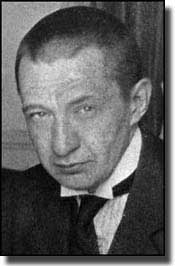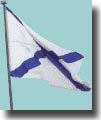|
Cruiser Aurora signals start of Russian Revolution in October 1917
On the 22nd. of May 1892, the cruiser Aurora had her keel laid at the New Admiralty shipyard in St Petersburg. Launched on the 11th. of May 1900, she joined the Imperial Russian Navy in July of 1903.
The Russian Cruiser Aurora secured in the Neva River at St Petersburg. During the Russo-Japanese War this ship was included in the Pacific Ocean Squadron having sailed to the Far East in October 1904.
Over the years 1906-1912 Aurora sailed the world, and in November 1911 was in Bangkok for the crowning of the King of Siam. In WW1 she took part in actions around the Baltic, and went into dock at Petrograd** in 1916 for repairs.
During the incredible 900 day seige of Leningrad, when some 641,000 people of the city died, Aurora moored at the mouth of the Gulf of Finland hammered the Nazi invaders around Leningrad with her main armament, but the old cruiser was eventually sent to the bottom. In 1957 she was raised and moved to her present location on the Neva River alongside a wharf close to the Hermitage. In 1987 a full restoration was carried out, and Aurora now houses the Museum of the Armed Uprising of October 1917. The Eastern Front.
Lenin who had been in exile in Austria and had moved into Switzerland, had just returned to Russia. He had arrived in a special sealed train provided for him by the German Foreign Ministry, who hoped he would be instrumental in bringing the war to an end, thereby releasing all the German troops who had been propping up the Eastern Front for redeployment to the now threatened Western Front. Lenin lead the Boleshevik group who were in a position with numbers and the leadership ability to get rid of the Provisional Government to bring both a Revolution and its new order to Leningrad and to wider Russia. Kerensky acts. Tthe Bolsheviks now set up their headquarters in the Smoleny Institute, and Kerensky, in an endeavour to bolster his position ordered the arrest of all the Military Revolutionary Committee on the 22nd. of October, he closed down the Bolshevik newspapers, and cut off all phones to the Smoleny Institute, but for him, time was quickly ebbing away.
Trotesky now urged the Bolsheviks to act, and throw out the Provisional Government, and he gained the agreement of Lenin. Orders went out to occupy the Railway stations, the important Telephone Exchange, and the State Bank, the Bolsheviks were on the move to taking control. The Red Guards who were made up of armed factory workers, surrounded the Winter Palace although it was defended by Cossacks, at 2100 ( 9 PM ) on the 25th. of October 1917, Aurora fired a shot into the Winter Palace, which was the signal to the Red Guards to attack. The Revolution that was to change both Russia and the world was under way. The Red Guards entered the Palace, arrested all the Cabinet Ministers, but Kerensky had slipped away. The next day power was handed over to the Soviet Council of Peoples Commissars, with Lenin as Chairman, Trotsky in charge of Foreign affairs, and Stalin putting his feet on the ladder leading to eventual control of the USSR, his first post that of Nationalities. Lenin soon took the new Socalist Government out of the war with Germany, much to the chagrin of the Allies, and signed a peace treaty with Germany.
I have twice visited this Venice of the North, the wonderful city of St Petersburg. I have stood on the wharf alongside this ship now over 100 years old, and marvelled at her condition today. It was spawned in Tsarist times, it survived the Battle of Tsushima against Japan, WW1, until it signalled the start of the Revolution by firing the first shot in October 1917. Aurora assisted in the seige of Leningrad in WW2, was sunk, recovered, and rebuilt. Sitting at its berth alongside the famous Hermitage, this ship has witnessed the demise of the old USSR, and the emergence of the present amalgam of individual States formed from the old Soviet Union. What does the future hold for a ship that has spanned all the differing regimes that have held sway in this part of the world? I suggest no one can answer that question.
Palace Square St Petersburg
|







